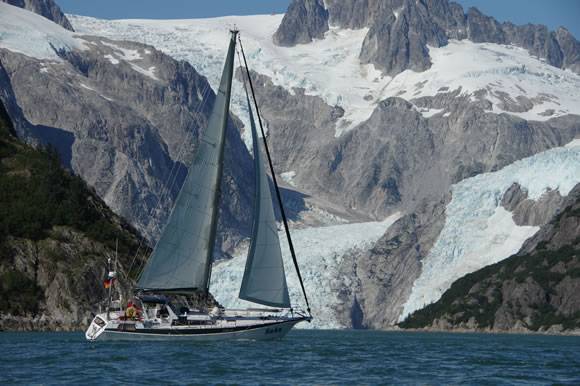Entry Date: 04.03.2015, at 18:00:00 hrs (local)
Okinawa (Japan) - Kasuura (Japan)

Clearing into Japan
| PRID: | 10841 |
|---|---|
| LegID: | 284 |
| LegNo: | 45 |
| Latitude: | N026°16.60' |
| Longitude: | E127°43.75' |
| Day#: | 483 |
| Log (Total): | 28675 nm |
The process of clearing into Japan started already back in Guam. It is required to send a “Prior Arrival Information” to the Japanese Coast Guard by Fax. It is also required to use an official form, which must be downloaded from the Internet. The form is six pages and does not distinguish between a giant cargo vessel, a super tanker or a small sailing vessel.
Arriving in Okinawa we contact Japanese Cost Guard via VHF. After some confusion we where eventually permitted to enter Ginowan Marina at 10:00 a.m. for clearance.
The Quarantine officer is already waiting for us on the dock. He fills in about five pages of forms. After checking our temperature we are declared healthy and are allowed to take down the yellow Quarantine flag.
Next two officers from Coast Guard come aboard. Again there are plenty of forms to fill in. After they have left, two other officers from Coast Guard ask for permission to come aboard. They are bringing even more forms and taking lots of pictures.
A little later Lutz is instructed to meet the Custom officers in the Marina Building. Custom did not want to see the vessel. Lutz was requested to fill in plenty of forms.
What about immigration? The marina stuff explains that immigration officers do not come to the vessel, but we have to go to see them in their office in Kadena. Unfortunately the office is in another town and we have to meet the challenge to get there. We manage to find our way by bus. In the immigration office we need to fill in even more forms, are photographed and fingerprinted and finally get the permission to stay in Japan for three month.
Are we finished with the paperwork? No, we are not!
There is the issue with the “Closed Ports”. Even though Japan has several hundreds of ports, just a handful of ports are “Open Ports”. There is a very stiff penalty if a vessel calls in a “Closed Port” without prior permission.
We learn that the Ministry of Transportation issues the permission. Unfortunately the ministry is in Naha. We have to fill in an application form with an attachment of all “Closed Ports” we intend to visit. In order to do this we need several volumes of the Small Craft Harbor Handbook. We learn it is sold in Naha. Going there, we also learn it is sold out. Luckily we are able to borrow most of the needed volumes from Pat. In the image is Gabi holding those volumes. It takes us two days to scan them. Since the books are completely in Japanese, we need to transfer the coordinates of the harbors from the books to our sea chart in order to find the English names. Those English names we transfer to the application form, which we make on the computer according to the template we’ve gotten.
We are taking the bus to Naha and locate the ministry. A very polite officer takes us trough all over 80 “Closed Ports”; one by one; and transfers the names from our neatly computer printed list to the proper form in handwriting. Three hours later our application is issued and we are asked to come back three days later.
On Thursday we are back in the ministry in Naha. We get the permission to call in to all our requested “Closed Ports”.
Now we are set to go up the chain of islands and the southwest coast of Kyushu. Before we can enter the Seto Inland Sea we have to do the whole process again.






